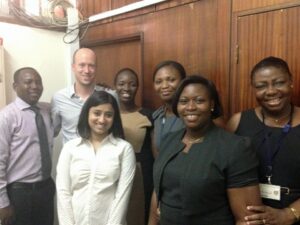Portfolio at Risk (PAR), or the percent of a financial institution’s loan portfolio that is delinquent, is a universally recognized indicator of a financial institution’s health. It is an important indicator, tracked by both institutions and investors, and this past week, I and two Credit Suisse employees had the opportunity to see for ourselves the story behind PAR, at least for a few financial institutions in Ghana. As I walked through a market that had no power and talked to market sellers dealing with low foot traffic because customers were turned off by the power outages, it was one more way to understand how a client can struggle to repay a loan and in effect, negatively impact the financial health of the institution serving that client.
 As part of our partnership with Credit Suisse we participate in the Global Citizens Program, engaging experienced employees in skills-based volunteering to further our mission while providing first-hand experience for volunteers in financial inclusion in emerging markets. Given our past experience in the country, Women’s World Banking helped Credit Suisse arrange a market study trip for two volunteers and last week, we travelled together to Ghana to better understand the opportunities in the market for reaching more low-income women with financial services and for investment. In a sense, we were there to get the story behind PAR and all the other numbers that make up a balance sheet for a financial institution serving the poor. The study covered the political and economic environment, analysis of the competitive landscape, assessments of market saturation, opportunities in digital banking and regulation among other topics and will provide background for new business development and potentially, future investments in the region. We met with financial institutions, low-income clients and private sector investors to understand both the macro environment and the challenges and opportunities for financial services.
As part of our partnership with Credit Suisse we participate in the Global Citizens Program, engaging experienced employees in skills-based volunteering to further our mission while providing first-hand experience for volunteers in financial inclusion in emerging markets. Given our past experience in the country, Women’s World Banking helped Credit Suisse arrange a market study trip for two volunteers and last week, we travelled together to Ghana to better understand the opportunities in the market for reaching more low-income women with financial services and for investment. In a sense, we were there to get the story behind PAR and all the other numbers that make up a balance sheet for a financial institution serving the poor. The study covered the political and economic environment, analysis of the competitive landscape, assessments of market saturation, opportunities in digital banking and regulation among other topics and will provide background for new business development and potentially, future investments in the region. We met with financial institutions, low-income clients and private sector investors to understand both the macro environment and the challenges and opportunities for financial services.
A disconnect between providers and clients
 There is an abundance of microfinance organizations and savings and loans cooperatives in Ghana yet we heard that anywhere from 40 to 60 percent of the urban population is unbanked, and recent numbers find that 70 percent of the entire population is unbanked. We heard that this is the case for a number of reasons:
There is an abundance of microfinance organizations and savings and loans cooperatives in Ghana yet we heard that anywhere from 40 to 60 percent of the urban population is unbanked, and recent numbers find that 70 percent of the entire population is unbanked. We heard that this is the case for a number of reasons:
- They don’t see banks as an improvement on what the informal sector is providing,
- They have a negative perception of microfinance because of some unscrupulous lenders that emerged after seeing the success that principled financial institutions were having in serving the low-income market, or
- They don’t think a bank will want their small savings.

The value of being on the ground
While much of this information is available online (including some recent actions by the Central Bank to better regulate the market), there is no substitute for meeting with management of the financial institutions and hearing first-hand their successes, challenges and plan to grow their institutions, especially the ways in which they plan to increase outreach to the low-income market in Ghana. It is hard to estimate, while sitting in New York, Chicago or London, the true effect of rolling 24-hour power outages, (“lights out” or dumsor as the locals call it), on a microentrepreneur and the costs to a bank branch to keep the generators running nearly daily. We visited a bank branch in the three-story Keneshi market, one of the biggest in Accra, and met clients who were sitting in near darkness, waiting for customers who had quit coming as the “dumsor” got increasingly frequent.
 It is these experiences that give us an understanding of a situation that we just can’t get by sitting in an office. Similarly, talking to locals to understand infrastructure constraints and inflation fears all give context to macroeconomic indicators and statistics that are easily accessed, but not always easily interpreted. Supporting corporate volunteer programs such as Credit Suisse’ Global Citizens Program is one way in which Women’s World Banking can collaborate with corporate partners to leverage additional valuable and skilled resources toward expanding our efforts to advance financial inclusion for low-income women around the world. But I also like to think that in exchange for volunteering their time, the Credit Suisse volunteers got some context, unique data points and experience a better understanding of how sophisticated microfinance has to be to find sustainable financial solutions for serving the poor.
It is these experiences that give us an understanding of a situation that we just can’t get by sitting in an office. Similarly, talking to locals to understand infrastructure constraints and inflation fears all give context to macroeconomic indicators and statistics that are easily accessed, but not always easily interpreted. Supporting corporate volunteer programs such as Credit Suisse’ Global Citizens Program is one way in which Women’s World Banking can collaborate with corporate partners to leverage additional valuable and skilled resources toward expanding our efforts to advance financial inclusion for low-income women around the world. But I also like to think that in exchange for volunteering their time, the Credit Suisse volunteers got some context, unique data points and experience a better understanding of how sophisticated microfinance has to be to find sustainable financial solutions for serving the poor.
Photo Credit: Pratyasha Rath, Credit Suisse



